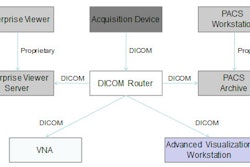Timely email notifications sent to notebook computers enabled radiology faculty to shave hours off the average turnaround time of radiology reports prepared by residents at a university hospital in Florida.
In January 2010, the University of Florida College of Medicine gave all radiology faculty members notebook computers with preloaded software that enabled them to easily sign radiology reports prepared by residents offsite. The objective was to reduce delays by attending radiologists in reviewing and signing off on residents' reports, according to an article published online March 1 in Academic Radiology.
With the system, emails are sent at 6:30 a.m. to every faculty member who has unsigned reports in the hospital's RIS queue. For each report, the email contains the patient's name, medical record number, exam description, data and time of the exam, name of the resident, and date and time when that resident approved the dictation. On average, each attending radiologist receives six to seven email reminders, with approximately nine unsigned reports per reminder.
Researchers from the radiology department conducted an analysis to determine if the notebooks and email notifications affected turnaround time and the way that attending radiologists reviewed their residents' reports. They queried the hospital's RIS to identify all radiology reports prepared by residents from January 1, 2009, through August 31, 2010.
A total of 293,434 reports were prepared by residents during a 13-month period prior to distribution of the notebooks. Thirty-four percent were modified by attending radiologists.
During the seven months of notebook use, 168,482 reports were prepared by residents and 32.5% were modified.
Report turnaround time was reduced by an average of 2.5 hours with computer notebook use. Whereas report turnaround time used to average 6.34 ± 16.4 hours, it subsequently averaged 4.35 ± 9.83 hours.
Attending radiologists were less likely to make changes in resident reports with the new system. Lead author Dr. Lori Deitte, an associate professor of the division of abdominal imaging, and colleagues suggested that the 12% reduction in changes made may have occurred because the faculty recipients did not pay as much attention to the report content. Another potential explanation is that they were not as picky about language, style, and format in the interest of providing a rapid sign-off.



















